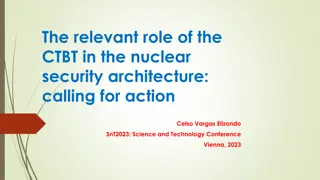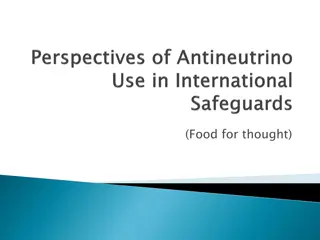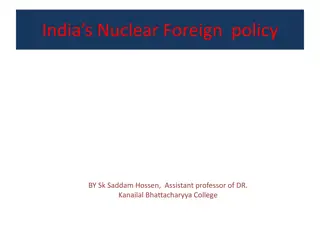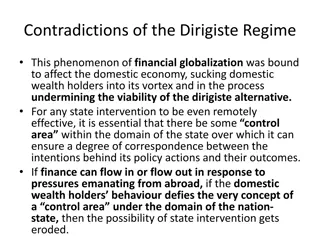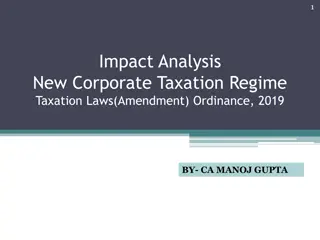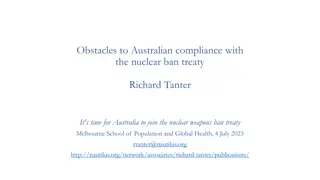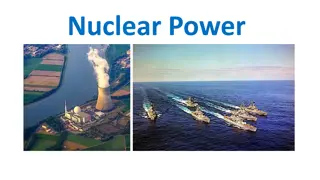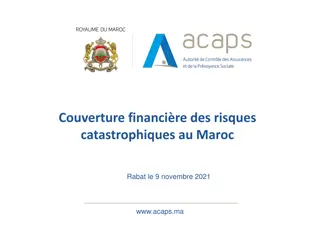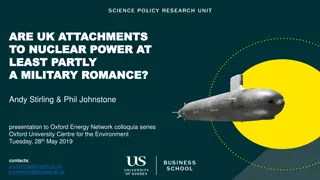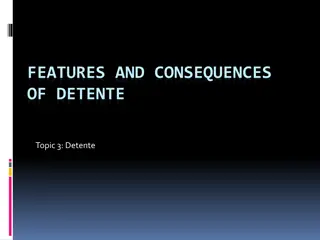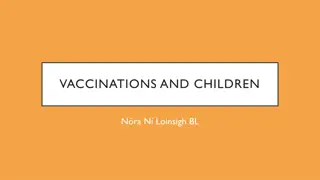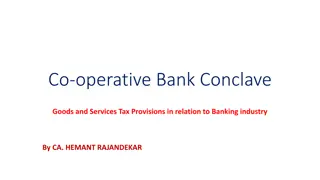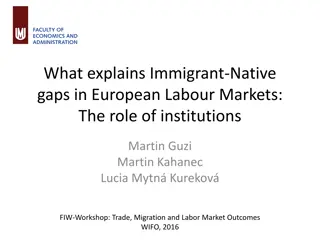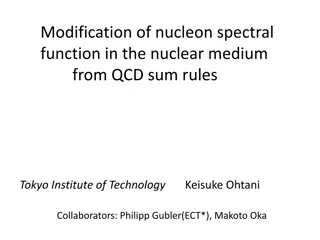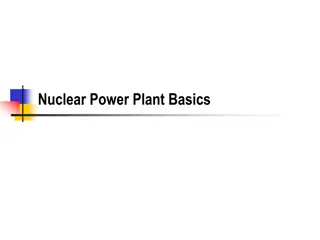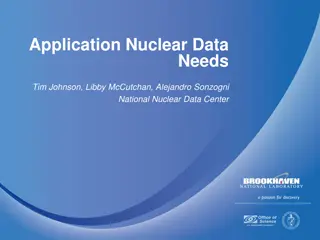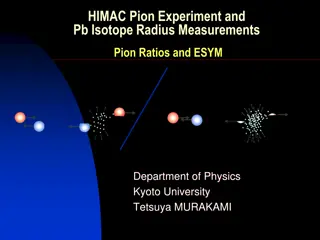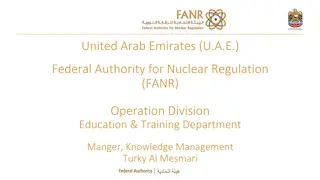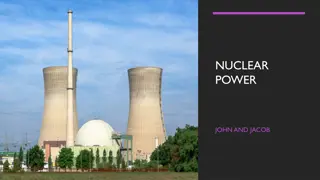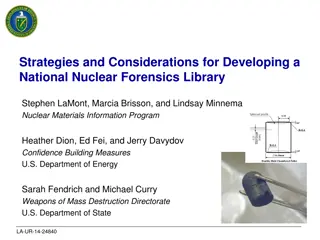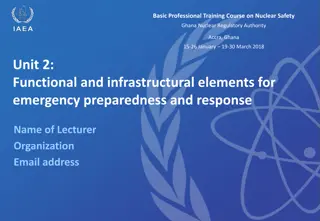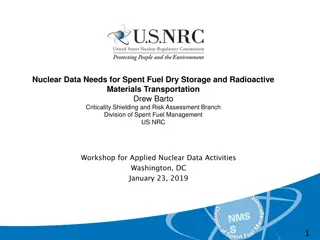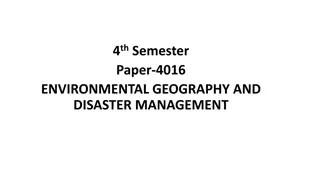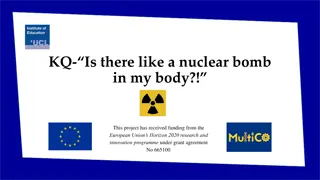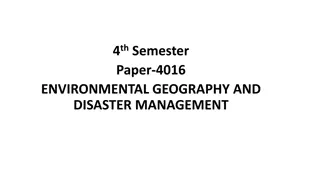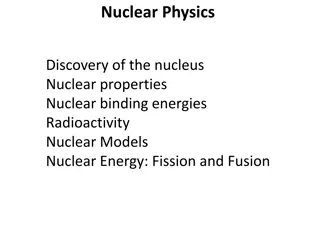Contemporary Challenges in Nuclear Disarmament and Non-Proliferation Regime
The international regime for nuclear disarmament and non-proliferation faces challenges from states within and outside the regime, as well as non-state actors. Various approaches are being utilized to address these challenges, including strengthening multilateral institutions, non-treaty-based multilateral initiatives, and ad-hoc approaches. The nuclear order has evolved since its inception, with debates on whether nuclear weapons ensure stability or pose a threat. The Nuclear Non-Proliferation Treaty aims to prevent the spread of nuclear weapons and reduce existing arsenals. Several states have abandoned their nuclear programs, while others have pursued or developed nuclear capabilities.
- Nuclear disarmament
- Non-proliferation regime
- International security
- Multilateral approaches
- Nuclear weapons
Download Presentation

Please find below an Image/Link to download the presentation.
The content on the website is provided AS IS for your information and personal use only. It may not be sold, licensed, or shared on other websites without obtaining consent from the author. Download presentation by click this link. If you encounter any issues during the download, it is possible that the publisher has removed the file from their server.
E N D
Presentation Transcript
22. NUCLEAR DISARMAMENT AND NON 22. NUCLEAR DISARMAMENT AND NON- - PROLIFERATION PROLIFERATION The international regime for the disarmament and non-proliferation of nuclear weapons faces three main contemporary challenges: 1. Those posed by states within the existing regime. 2. Those from states outside the present regime. 3. Those from nonstate actors. These challenges have generated at least three different approaches: 1. efforts to strengthen the traditional multilateral institutional approach anchored in treaty-based regimes; 2. efforts through non-treaty based multilateral approaches initiated within the UN system; 3. efforts to build a set of ad-hoc, non-institutional, non- conventional approaches outside the UN to address the immediate challenges of proliferation. Security Studies: An Introduction. 4th Edition. Paul D. Williams and Matt McDonald. Routledge 2023. Paperback ISBN - 9781032162737 Information Classification: General
THE NUCLEAR ORDER THE NUCLEAR ORDER Soon after nuclear weapons first appeared in 1945, they came to be viewed as the principal guarantors of peace between the superpowers during the Cold War. Early efforts, such as the Baruch and Gromyko plans (1946), to control and eliminate them failed. Even after the Cold War, the possession of nuclear weapons is still perceived by some states as the fundamental basis for international order and a crucial part of ensuring their national security. Scholars debate whether nuclear weapons are a source of international stability (because of the concept of mutually assured destruction ) or a threat (because of questionable assumptions of rationality, dangers of accidental use or misperception, potential for proliferation to rogue regimes or nonstate actors, and their destructive capacity). Security Studies: An Introduction. 4th Edition. Paul D. Williams and Matt McDonald. Routledge 2023. Paperback ISBN - 9781032162737 Information Classification: General
THE NUCLEAR NON THE NUCLEAR NON- -PROLIFERATION TREATY PROLIFERATION TREATY By 1 July 1968, when negotiations for the nuclear Non-proliferation Treaty (NPT) were completed, only five states (the United States, the Soviet Union, United Kingdom, France, and the People s Republic of China) had tested nuclear weapons. The NPT s ambitious goal was to prevent other states from acquiring nuclear weapons, curb the unfettered build- up of these weapons among possessor states, and, ultimately, eliminate all of them. The existing global nuclear arsenal is around 13,000 weapons, down from a peak of around 80,000 in the late 1980s. The number of known nuclear weapons states has risen from five in 1968 to nine by 2006, including Israel, India, Pakistan, and the Democratic People s Republic of Korea (DPRK). Several states, including Bulgaria, Canada, Germany, Italy, Japan, the Netherlands, Norway, and Spain, did not pursue a nuclear weapons programme despite having the technical wherewithal to do so. Argentina, Australia, Brazil, Egypt, Poland, Romania, Republic of Korea, Spain, Sweden, Switzerland, Taiwan, and Yugoslavia had nuclear weapons programmes during the Cold War but abandoned them. Libya, suspected of having started a clandestine nuclear weapons programme at the end of the Cold War, terminated it in 2003. Since 1990, South Africa, Belarus, Kazakhstan, and Ukraine, which possessed nuclear weapons, also gave them up. Security Studies: An Introduction. 4th Edition. Paul D. Williams and Matt McDonald. Routledge 2023. Paperback ISBN - 9781032162737 Information Classification: General
WORLD NUCLEAR FORCES, JANUARY 2021 WORLD NUCLEAR FORCES, JANUARY 2021 SOURCE: ADAPTED FROM SOURCE: ADAPTED FROM SIPRI YEARBOOK 2021 SIPRI YEARBOOK 2021 (OXFORD UNIVERSITY PRESS, 2021), P.334. P.334. (OXFORD UNIVERSITY PRESS, 2021), State Year of first nuclear test Deployed warheads Stored warheads Other warheads Total inventory United States Russia United Kingdom France China India Pakistan Israel North Korea Total . . = not applicable or not available; = nil or negligible; [] = uncertain figure. 1945 1949 1952 1,800 1,625 120 2,000 2,870 105 1,750 1,760 5,550 6,255 225 1960 1964 1974 1998 280 10 350 156 165 90 . . . . . . . . 290 350 156 165 90 . . . . 2006 [40-50] 3,510 [40-50] 13,080 3,825 5,745 Security Studies: An Introduction. 4th Edition. Paul D. Williams and Matt McDonald. Routledge 2023. Paperback ISBN - 9781032162737 Information Classification: General
THE NUCLEAR NON THE NUCLEAR NON- -PROLIFERATION REGIME PROLIFERATION REGIME Although the NPT is the lynchpin of the non-proliferation regime, the regime itself is much broader and is comprised of multilateral treaties and agreements. These include the Partial Test Ban Treaty (PTBT) and the Comprehensive Test Ban Treaty (CTBT), which seek to ban nuclear tests; the Outer Space Treaty (1967), which prohibits placing WMDs in Earth s orbit, on the Moon or any other celestial body; the proposed Fissile Material Cutoff Treaty (FMCT), which aims to ban the production of fissile material; Nuclear Weapon Free Zones (NWFZs), which have effectively made the entire southern hemisphere free of nuclear weapons; bilateral agreements to limit nuclear arsenals, particularly between the US and the Soviet Union/Russian Federation, such as SALT I & II, the Anti-Ballistic Missile (ABM) Treaty, the Intermediate-Range Nuclear Forces (INF) Treaty, and the START I, II and III agreements; informal technology denial regimes, such as the Nuclear Suppliers Group (NSG) and the Missile Technology Control Regime (MTCR); and the institution of the International Atomic Energy Agency (IAEA) to ensure compliance of key aspects of the NPT regime. Security Studies: An Introduction. 4th Edition. Paul D. Williams and Matt McDonald. Routledge 2023. Paperback ISBN - 9781032162737 Information Classification: General
THREE CAVEATS THREE CAVEATS 1. Nuclear weapons do not belong to the broader conceptual category of so- called Weapons of Mass Destruction (WMD) because they are far more lethal than biological and chemical weapons and a variety of protective measures exist to alleviate the effects of some chemical or biological attack. The creeping tendency to redefine the mission of nuclear weapons to counter all WMD has two unhelpful consequences: it lumps together biological, chemical, and nuclear weapons into one fuzzy conceptual category, and it weakens the nuclear taboo. Proliferation must include both vertical (qualitative and/or quantitative improvement in the arsenals of states that already possess nuclear weapons) and horizontal (the quest of new states to acquire nuclear weapons) proliferation. As represented in the NPT package, nuclear non-proliferation must be linked to nuclear disarmament. However, recent efforts have been made to de-link non-proliferation and disarmament and focus only on horizontal proliferation. 2. 3. Security Studies: An Introduction. 4th Edition. Paul D. Williams and Matt McDonald. Routledge 2023. Paperback ISBN - 9781032162737 Information Classification: General
THREE CHALLENGES THREE CHALLENGES Signatory States: states breaking their commitment within the existing non-proliferation regime. This includes states that announced their intention to withdraw from the NPT, built and tested a nuclear weapon, such as the DPRK, and the original five NPT nuclear weapons states, which are qualitatively improving their arsenals and developing a new generation of potentially usable nuclear weapons. Non-Signatory States: states failing to sign or ratify key agreements, including India, Israel, and Pakistan, which have not signed the NPT or the CTBT, but also states which have not ratified the CTBT, including China, the DPRK, Egypt, Iran, Israel, and the United States. Nonstate Actors: UN Security Council Resolution 1540 (2004) was especially concerned about transnational or subnational fundamentalist or cult groups, such as Aum Shinrikyo, al-Qa ida or the Islamic State trying to acquire nuclear weapons, as well as nuclear scientists, such as Dr. A.Q. Khan, hawking their materials and expertise. Security Studies: An Introduction. 4th Edition. Paul D. Williams and Matt McDonald. Routledge 2023. Paperback ISBN - 9781032162737 Information Classification: General
UKRAINE AND NUCLEAR DANGERS UKRAINE AND NUCLEAR DANGERS Russia s latest invasion of Ukraine in February 2022 poses at least four nuclear dangers: 1. Potential escalation to nuclear war through deliberate action, or misunderstanding, or by accident. This would also break the over seven decade-long taboo against use, which has been formally enshrined in the TPNW. Disarmament commitments may be irrevocably reversed. Whatever the war s outcome, it appears unlikely that the US and Russia will be able to negotiate a successor to START III, or that China will be willing to participate. Instead, nuclear weapons buildup likely. Incentive to proliferate. When Ukraine acceded to the NPT in 1994 it gave up 1,900 Soviet- era nuclear weapons (the third largest global holding) and was regarded a triumph of non- proliferation. Kyiv s actions were facilitated by the Budapest Memorandum (1994), which guaranteed that Russia, the US, and the UK (the three depositories of the NPT) would refrain from the threat or use of force against the territorial integrity or political independence of Ukraine, and that none of their weapons will ever be used against Ukraine . Russia s egregious violation of the Memorandum will, doubtless, compel nuclear-armed countries outside the regime, such as DPRK, not to part with their weapons, while some non-nuclear NPT adherents might now consider acquiring them. Threat to civilian nuclear power plants. The attacks and seizure of Chernobyl the ill-fated nuclear power plant that suffered a nuclear meltdown in 1986 and Zaporizhzhia the largest nuclear power plant in Europe by Russian troops was unprecedented , according to IAEA Director General Rafael Grossi. 2. 3. 4. Security Studies: An Introduction. 4th Edition. Paul D. Williams and Matt McDonald. Routledge 2023. Paperback ISBN - 9781032162737 Information Classification: General
THREE APPROACHES THREE APPROACHES These three sets of challenges to the non-proliferation regime have generated at least three different approaches to address them: 1. Treaty-based multilateralism: traditional multilateral institutional approaches anchored in negotiated treaty-based regimes, such as the 1963 PTBT, the 1968 NPT, the 1996 CTBT, and the 2017 TPNW. 2. Non-treaty-based multilateralism: because of weaknesses in the multilateral system, a series of non-treaty based multilateral approaches were adopted after 1989, such as the various declarations and resolutions made by the UN Security Council and the General Assembly. 3. Ad hoc responses from individual states or coalitions: non-institutional, non- conventional approaches including the preventive war ostensibly against Iraq s nuclear, chemical and biological weapons in 2003; the US-led Proliferation Security Initiative (PSI); the six-party talks, followed by the Trump-Kim Jong Un dialogue to address the DPRK s nuclear ambitions; the Indo-US civilian nuclear initiative; and the four Nuclear Security Summits (NSS), which took place between 2010 and 2016 with the ambitious objective to secure all vulnerable nuclear material in four years . Security Studies: An Introduction. 4th Edition. Paul D. Williams and Matt McDonald. Routledge 2023. Paperback ISBN - 9781032162737 Information Classification: General
CONCLUSION CONCLUSION Overall, liberal and institutional scholars would generally prefer strengthening the multilateral treaty-based institutions to address the non-proliferation challenges rather than opt for ad hoc options. In contrast, realists appreciate some ad hoc (unilateral or coalition) initiatives, including the use of force, to secure states from other states and nonstate actors. However, ad hoc approaches alone are unlikely to be effective either in the short- or the long- term unless they are intrinsically linked to the universally applicable norms, and treaty-based regimes. Hence, realists and liberals should bridge their differences and seek a middle ground. In addition, countries which are presently under the extended nuclear umbrella of nuclear weapons states should consider whether their perceived reliance on such weapons is undermining nuclear disarmament, as is evident from their boycott of the TPNW negotiations. Finally, one interesting scenario would involve a current permanent member of the UN Security Council giving up their arsenal. What are the prospects for one of the nuclear weapons states thinking it could ensure its security without nuclear arms? It might set the stage for creating a new international order not based on nuclear weapons and reforming the Council. Security Studies: An Introduction. 4th Edition. Paul D. Williams and Matt McDonald. Routledge 2023. Paperback ISBN - 9781032162737 Information Classification: General
ESSAY / EXAM QUESTIONS ESSAY / EXAM QUESTIONS Is the nuclear taboo getting stronger or weaker? Explain your answer with examples. What is the relationship between disarmament, arms control, non-proliferation and international security? What makes nuclear weapons distinct from other weapons of mass destruction? How has the non-proliferation regime evolved since the end of the Cold War? What are the three approaches being pursued to advance nuclear disarmament and non- proliferation? Does gender play a role in nuclear disarmament? What could disarmament, arms control and non-proliferation look like in 25 years? Will the conditions ever prevail for complete nuclear disarmament? Are some nuclear weapon states essential to prevent further proliferation? In the absence of nuclear guarantees, do states have the right to build nuclear weapons to ensure their own security? What are the major nuclear dimensions of the war in Ukraine and why are they important beyond Ukraine? Security Studies: An Introduction. 4th Edition. Paul D. Williams and Matt McDonald. Routledge 2023. Paperback ISBN - 9781032162737 Information Classification: General
WEBSITES AND AUDIO WEBSITES AND AUDIO- -VISUAL RESOURCES VISUAL RESOURCES Introducing weapons of mass destruction and nuclear proliferation Feature films on nuclear proliferation and disarmament On the Beach (1959):https://www.youtube.com/watch?v=MOFsOA9VsBk Atomic Archive website, supported by National Science Foundation: http://www.atomicarchive.com/index.shtml Dr. Strangelove or: How I learned to Stop Worrying and Love the Bomb (1964): https://www.youtube.com/watch?v=0IiUTBEdSwk Bulletin of Atomic Scientists: http://thebulletin.org/ The Day After (1983): https://www.youtube.com/watch?v=MOFsOA9VsBk The Arms Control Association: https://www.armscontrol.org/newarchivesearch. War Games (1983):https://www.youtube.com/watch?v=hbqMuvnx5MU The Nuclear Threat Initiative: http://www.nti.org/learn/ Failsafe (1964 or 2000): 1964:https://www.youtube.com/watch?v=CNNMiSEZd9Y 2000:https://www.youtube.com/watch?v=p-6xcIUwPto Melissa Gillis, Disarmament: A Basic Guide, Third Edition (New York: UN Publications, 2012) (https://www.un.org/disarmament/publications/basic-guide/edition- 3/) Thirteen Days (2000): https://www.youtube.com/watch?v=-yfIoHXOO9E The Government Inspector (2005): :http://www.screenonline.org.uk/tv/id/1419043/index.html United Nations Office for Disarmament Affairs: https://www.un.org/disarmament/ Green Zone (2010):https://www.youtube.com/watch?v=e3KJ21TLKVE The Man Who Saved the World (2015):https://www.youtube.com/watch?v=VaPXVJWHji4 Command and Control (2016):https://www.youtube.com/watch?v=Y4evcOi-EkQ Security Studies: An Introduction. 4th Edition. Paul D. Williams and Matt McDonald. Routledge 2023. Paperback ISBN - 9781032162737 Information Classification: General


